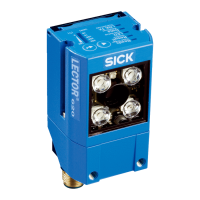ONLINE HELP SOPAS Chapter 5
LECTOR®620
Parameters
8013778/Y269/2013-11-27 © SICK AG · Germany · All rights reserved · Subject to change without notice 83
5.8.5.2.2 Teach-in stop by
Depending on the setting for the Start teach-in parameter, the Teach-in stop by parameter
is used to define which signal or condition stops teach-in of the matchcode.
• T
EACH-IN TRIGGER SOURCE: Teach-in is stopped by a signal (e.g. a key switch) at one of the
digital inputs of the LECTOR
®
620.
• O
BJECT TRIGGER: Teach-in stops as soon as the reading gate is closed.
• T
AUGHT VALID CODE: Teach-in stops as soon as a matchcode was read successfully.
5.8.5.2.3 Teach-in condition
The Teach-in condition parameter defines the condition in which the newly taught-in match
code content is stored. The selected condition is used as a basis when activating the target/
actual comparison. Each code that is read is compared to the read-in code content for the
target condition.
The code contents to be compared are assigned to a condition via the Teach-in condition
parameter. The taught-in match codes can be started and activated at a later time, subject
to the condition.
5.8.5.2.4 Invert condition
A condition can be inverted using the Invert condition parameter. Inverting a condition al-
lows all code contents to be approved except the taught-in match code content.
With this function, it is possible to prevent a particular product from leaving the production
line.
5.8.5.2.5 Teach-in code content
If the Teach-in code content parameter is activated, the code content of the matchcode is
taught in and included as a condition.
This reduces the likelihood of the code being confused with other codes.
5.8.5.2.6 Teach-in code ID (type)
If the Teach-in code ID (type) parameter is activated, the code type of the matchcode is
taught in.
This reduces the likelihood of the code being confused with other codes.
5.8.5.2.7 Teach-in code length
If the Teach-in code length parameter is activated, the code length of the matchcode is
taught in.
This reduces the likelihood of the code being confused with other codes.

